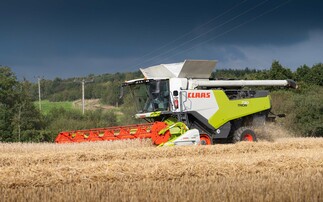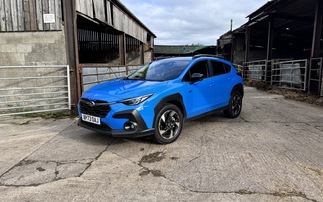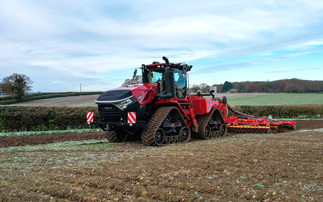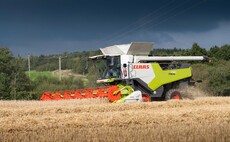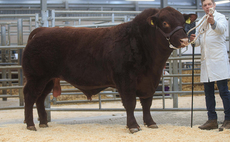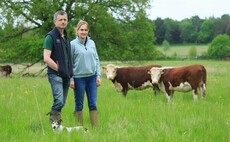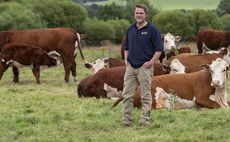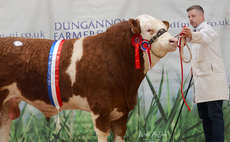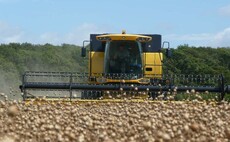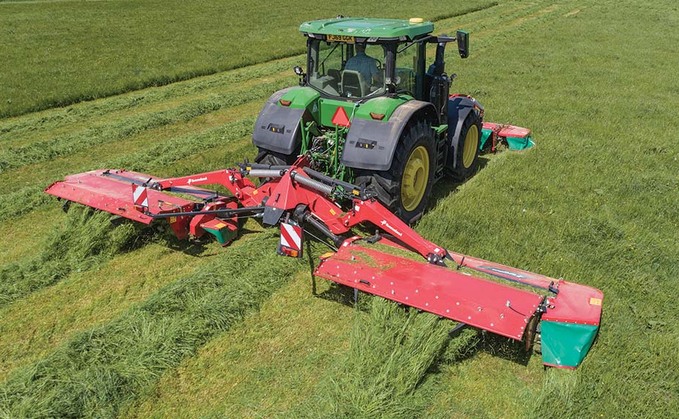
Diving into Kverneland's extensive range of mowers, for our latest test drive we focus on the firm's 5087 MN butterfly mower. Billed as a simple set of lightweight mowers, James Rickard finds out more.
Following on from our test drive of John Deere's latest Generation 2 7R tractor, eagle eyed readers may have noticed the band new set of Kverneland triple mowers which we used with the tractor. Not to miss an opportunity, this gave us an ideal chance to find out more about these mowers, which the manufacturer is pitching as a light weight set of simple triple mowers. In particular, the rear 5087 MN ‘butterfly' unit is designed to appeal to farmers which want to increase mowing output, but make the most of available power on-farm without having to resort to buying a ‘large' tractor to power them.
Key aspects to achieve this include a 2,130kg lightweight design and the use of nylon tine conditioners. Features which can be found on the firm's larger and higher-spec mowers have also been omitted, to keep the mowers as simple as possible. Instead, you get a fixed working width of 8.7m, simple sprung suspension, spool-controlled lift and basic adjustment of swathing vanes. However, this is not to say the mowers are awkward to use, as they are packed with several useful features to make operation easier (see panels for details).
Despite us using these mowers with a 300hp-plus tractor, simply due to the availability of the Deere and the KV kit, these mowers are said to be a good match for medium tractors from 160 to 200hp. And having initially tried them on the test farm's Case IH Puma 165, which boosts to 210hp, we can confirm they are a good match for this size of tractor, not only in terms of power requirement, but their relative lightweight also means a tractor like this can handle them when it comes to lift and balance.
Our test drive saw the 5087 MN rear butterfly unit partnered with KV's 3632 FN suspended/pull-type front mower. Using the same mower bed as the rear units, it offers a cutting width of 3.16m and features the same nylon tine conditioner to match the rear set.

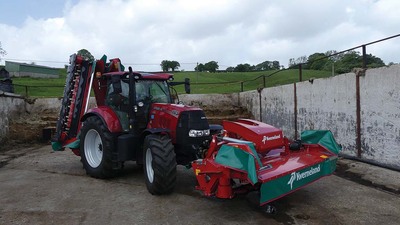
Specifications
Model | 5087 MN | 3632 FN |
Overall cutting width | ||
Number of discs | Eight per mower | |
Conditioner type | Nylon tines | Nylon tines |
Conditioner speed | 600 or 900rpm | 600 or 900rpm |
Power requirement | 150hp-plus | 80hp-plus |
2,130kg | 1,260kg | |
List price | £36,667 | £16,011 |
Suspension

Part of the latest generation of mowers from Kverneland, construction of the 5087 MN butterfly is a very simple and neat design, which sees each 3.16m (cutting width) mowing unit independently suspended by its own arm. From the central main frame each arm (left and right) is connected to the centre of each mowing unit, offering a good amount of travel for lifting and contour following.
Acting upon the lift arms is a simple spring suspension system which can be adjusted via chain links. If you wanted to go one step further, hydraulic adjustment of the springs can be specified, but the basic system works very well as it is.
The butterfly unit can be stored either folded out or in its vertical transport position. For the latter, in-built, fold out stands support the machine. In either storage position, the tension in the spring suspension can be released, which in theory should help to prolong spring life.
Practicalities
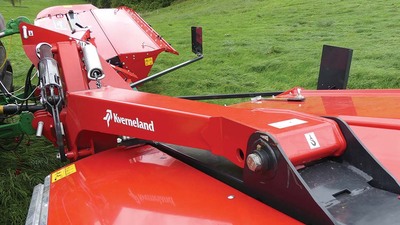
Helping balance, the butterfly's main frame has been designed to be as close as possible to the tractor, bringing weight as far forward as possible.
As mentioned, working width is a fixed 8.7m. However, it is possible to reduce this by using a different set of holes where the mowing units are fixed to the lift arms, offering greater overlap with the front mower. This, for example, could be useful if you have a lot of odd-shaped headlands or several in-field obstacles to navigate, and want to avoid/reduce ‘misses' between the front and rear mowers. This said, with the rears set at 8.7m, overlap between front and rear mowers is quite a generous 375mm on each side.
Road lighting is also standard on both the front and rear mowers, which also feature easy-to-fold steel end guards and on-board storage for blades.
Mowing bed
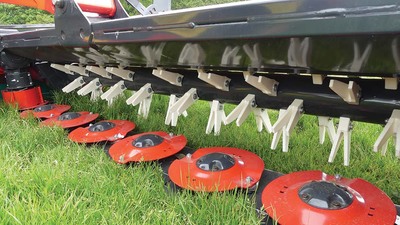
Giving a clue to the mower's Taarup heritage is the use of round mowing discs, which it introduced in 1968. Taarup was also the first manufacturer produce a mower/conditioner in one; that was 1974 with the TSC2100.
In theory, round discs are said to deal with foreign objects better, as the distance between each disc is always constant, unlike oval discs, says the manufacturer.
However, should a disc strike a foreign object, such as a set of chain harrows that have been forgotten about in a patch of nettles, each disc is protected by a shear hub. And should the mowers hit an immovable object, like that stump that was not there a moment ago, a break-back protection system will see the mowing units swing rearwards. Also, this pivot point is behind the tractor, towards the centre, which in theory should be more forgiving compared to a system that pivots behind the tractor's back wheels.
Like many mounted mowers, cutting height (stubble height) is altered by the top link on both the front and rear mowers. Various skids can also be fitted, including 20, 40, 60 and 80mm options.
Cutting discs
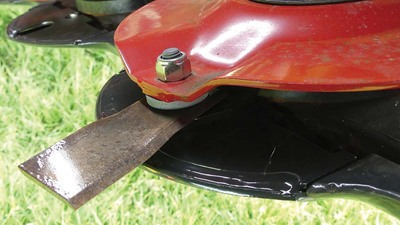
Despite appearances with a nut above each blade, blades are ‘quick fit', simply done by inserting a tool under the disc and cranking it over. A jaw then releases the blade.
KV has made its own mowing beds for the last 30 years, using a fully welded design which allows the bed to flex without affecting gaskets. It also holds lots of oil at 4.4 litres, enabling it to run cooler and extend service intervals up to 200 hours or once per season. Each mower is also slip-clutch protected on the input shaft.
In addition, access to the mowing beds is helped a lot by the front portion of the metal hood, which can be swung out of the way.
Conditioning
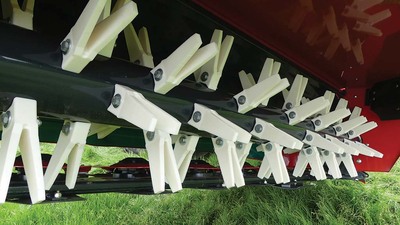
As for the nylon conditioner, tine construction is chunky to say the least. When new, we would expect these to be more aggressive than steel tines; probably less so once they start to wear. They also do not fold back like steel tines, so have little forgiveness for foreign objects.
Conditioning intensity can be easily altered via a lever which moves the conditioning hood closer or further away from the conditioner. A thinner profile hood can also be specified for a less intensive action. Also, conditioner speed can be switched between 600 and 900rpm via a set of belts and pulleys on each mower.
Belts are kept under tension by springs, with a clear visual indicator letting you know the state of the belts.
Swathing
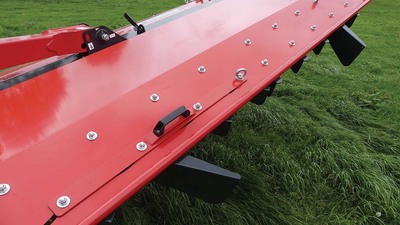
Keeping with the simple theme, switching from swathing to spreading has also been thought about. Unlike the flip-over hood of its higher-spec stablemates, the 5087 MN sees halve of its swathing vanes on each of its rear mowers connected by a parallel linkage. And with one action, the angle of five vanes can all be altered at once.
As for the other half, which are positioned towards the outside of the butterfly's mowing units, these are in a fixed position and guide the crop towards the centre of the machine. With the front mower's swath boards set fully out, it is possible to make an almost even mat of spread out crop across the full width of the machine.
In addition, depending on desired swath width, extensions on the outer swath boards can be used to further direct crop into a swath.
Control
For control there are no control boxes or IsoBus connections to mess with, just two double acting spools; one for the left mowing unit and one for the right.
These spools are used to raise and lower each mower, and also used to raise the mowers into their transport position. For folding and unfolding, ropes are puled to release a mechanism which allows the full movement of the rams, enabling them to fold/un-fold the mowers for transport.
Front mower
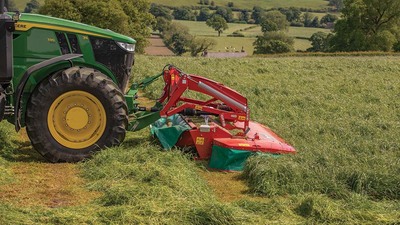
As for the front mower, this compliments the rear butterfly unit well. While it has been on the market for about six years, it still offers good suspension travel to follow contours, even compared to Keverneland's latest design as used on its newer and higher-spec mowers.
As a suspended/pulled mower, it provides 400mm of upwards movement, 300mm of downward movement and 24 degrees sideways tilt, which is substantial when compared to competitors on the market. When the mower rides over a hump, for example, the mower bed tilts backwards to follow the hump. Similarly, when the mower drops into a dip, the mower bed tilts forwards. Similar to the rear unit, suspension is spring adjusted via screws.
Two swath boards with extensions allow swath width to be adjusted. These can also be completely removed for a full width spreading action.
For storage, the mower features its own drop down parking legs. However, the clips that hold these in place are susceptible at coming off when working, so best to take these off and leave in the yard.
To help hooking up and dropping off, the mower's suspension frame can be locked solid, with an A-frame used to attach it to the tractor.
Verdict
Other models have all the features and control bells and whistles you could want but the 5087 MN butterfly mower-conditioner foregoes operator convenience to keep the combination as light as possible and therefore to suit a 160-200hp tractor.










